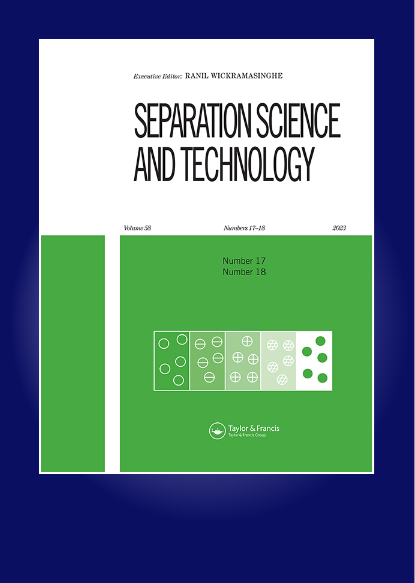成功制备去除水中苯胺染料的三共聚物水凝胶:实验和离散傅立叶变换研究
IF 2.3
4区 工程技术
Q3 CHEMISTRY, MULTIDISCIPLINARY
引用次数: 0
摘要
摘要:本研究制备了具有ph敏感表面的高分子水凝胶。用扫描电子显微镜观察了合成材料的表面形貌。采用brunauer - emmet - teller法测定水凝胶的表面积和孔径。利用傅里叶变换红外光谱对吸附剂表面的各种官能团进行了鉴定。这些水凝胶在从污染的水中去除有毒的甲苯胺染料方面非常有效。采用动力学和等温模型计算了合成材料的吸附参数。与其他模型相比,拟二阶和Langmuir模型对吸附数据的解释无可挑剔。热力学研究证实了反应的自发性。在本研究中,焓值(∆H°)为7322.6 kJ/mol。甲苯胺染料在293K、313K和333K时的吉布斯能(∆G°)分别为- 453.9、- 984.4和- 1515.2 kJ/mol,表明该反应为吸热自发反应。甲苯胺染料的熵值(∆S°)为26.54 Jmol/K。采用密度泛函理论模拟研究了吸附剂和甲苯胺染料分子表面各种官能团的相互作用。不同配合物的结合能均较大(- 5.73 ~ - 25/74 kcal/mol),表明水凝胶对甲苯胺染料分子具有较强的吸附能力;这些结果与实验结果一致。研究表明,所合成的水凝胶是一种去除水中苯胺染料的高效吸附材料。制备的水凝胶对苯胺染料的吸附量为526 mg/g。本文章由计算机程序翻译,如有差异,请以英文原文为准。
Successful preparation of tercopolymer hydrogel for the removal of toluidine dye from contaminated water: Experimental and DFT study
ABSTRACT Polymeric hydrogel with pH-sensitive surface was prepared in this study. The surface morphologies of the synthesized materials were examined using scanning electron microscopy. Surface area and pore sizes of the hydrogels were determined using Brunauer–Emmett–Teller. Fourier transform infra-red spectroscopy was used for the identification of various functional groups on the surface of these adsorbents. These hydrogels were extremely efficient in removing toxic toluidine dye from contaminated water. Kinetics and isothermal models were used for the calculations of adsorption parameters of the synthesized materials. The adsorption data were impeccably explained with pseudo‐second order and the Langmuir model as compared to other models. The spontaneity of the reaction was confirmed by thermodynamic study. In this study the value of enthalpy (∆H°) was 7322.6 kJ/mol. The values of Gibbs energy (∆G°) were −453.9, −984.4 and −1515.2 kJ/mol, at 293K, 313K and 333K, respectively, for toluidine dye, which showed that the process is endothermic and spontaneous in nature. Moreover, the value for entropy (∆S°) was calculated as 26.54 Jmol/K for toluidine dye. The interactions of various functional groups on the surface of adsorbent and toluidine dye molecules were studied with density functional theory simulations. The large binding energies (−5.73 to −25/74 kcal/mol) of different complexes showed that the hydrogels had strong affinity for the adsorption of toluidine dye molecules while the negative values revealed that the process is spontaneous and endothermic. These results were consistent with the experimental results. This study revealed that the synthesized hydrogel is efficient adsorbent material for toluidine dye removal from contaminated water. The adsorption capacity of the prepared hydrogel was 526 mg/g for toluidine dye.
求助全文
通过发布文献求助,成功后即可免费获取论文全文。
去求助
来源期刊

Separation Science and Technology
工程技术-工程:化工
CiteScore
6.10
自引率
3.60%
发文量
131
审稿时长
5.7 months
期刊介绍:
This international journal deals with fundamental and applied aspects of separation processes related to a number of fields. A wide range of topics are covered in the journal including adsorption, membranes, extraction, distillation, absorption, centrifugation, crystallization, precipitation, reactive separations, hybrid processes, continuous separations, carbon capture, flocculation and magnetic separations. The journal focuses on state of the art preparative separations and theoretical contributions to the field of separation science. Applications include environmental, energy, water, and biotechnology. The journal does not publish analytical separation papers unless they contain new fundamental contributions to the field of separation science.
 求助内容:
求助内容: 应助结果提醒方式:
应助结果提醒方式:


